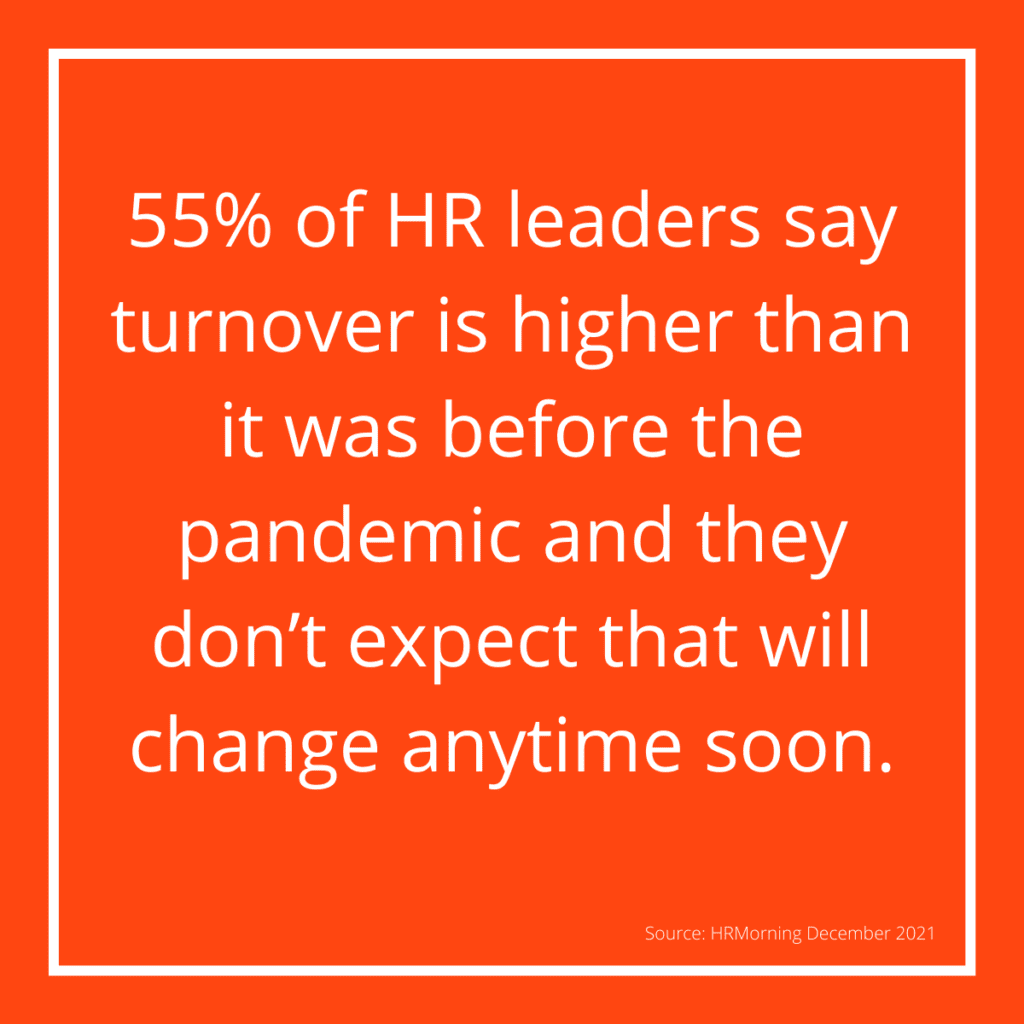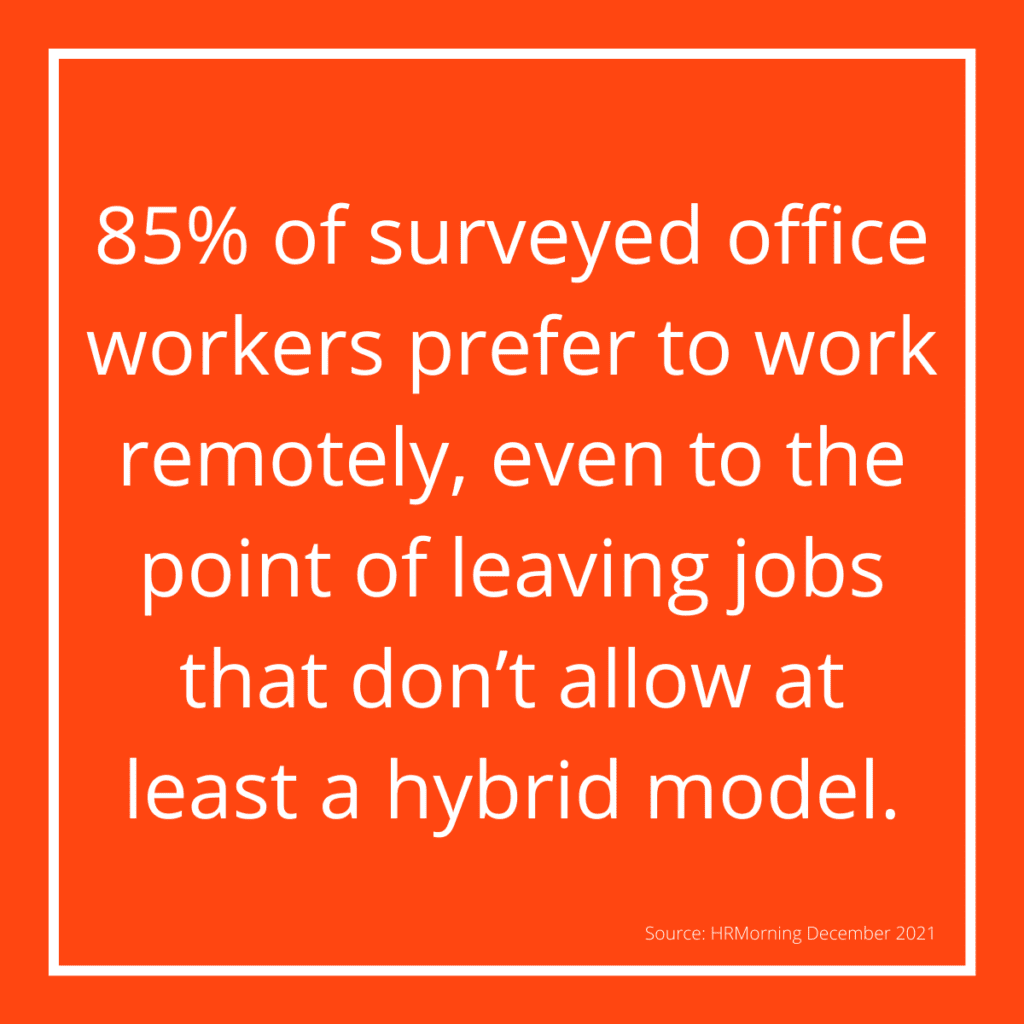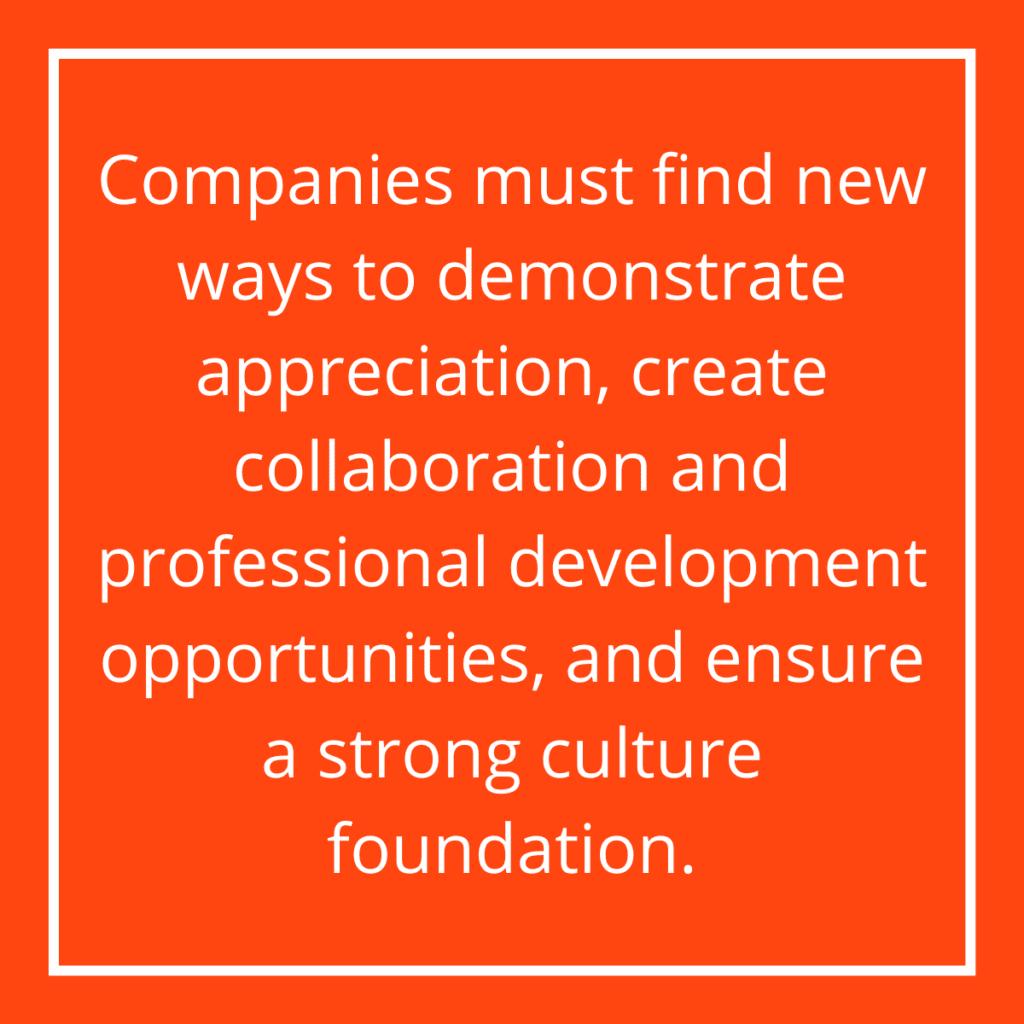There is no question that business is anything but usual these days, particularly when it comes to human resources and recruiting. The events of the past two years have forever transformed the employer-employee relationship including how and where people work, employee expectations and needs and hiring challenges and increased attention to and concern for work/life balance.
With this in mind, we’ve identified the top HR trends for 2022 and how to optimize the good trends and reverse the bad ones.

High turnover rates continue: Nearly 55% of HR leaders say turnover is higher than it was before the pandemic – and they don’t expect that will change anytime soon. So, how can businesses combat it?
Here at Acronym, we enjoy unprecedented employee retention because our leadership team takes the time to connect with all members of their respective groups. Whether through townhalls, team chats, cross-functional collaboration or just personal check-ins, group leaders regularly to listen to team members and address concerns.
In any business, open dialogue is critical. As the saying goes, you can’t fix what you don’t know is broken. Put another way – the first step to solving a problem is to recognize you have one. Creating an environment where everyone knows their voices are heard ensures that problems are solved.
Hiring and onboarding remotely will continue. Because remote work is here to stay, creative virtual/online interviews and onboarding practices will be needed in 2022 to create a clear and compelling process. We’ve implemented three new HR systems this year, including Greenhouse Recruiting and Onboarding platforms as well as BambooHR for HRIS.
These tools streamline the virtual process of application-to-hire for the new employee as well as the hiring manager. No more clumsy attachments of paperwork sent from some faceless void. A fully digital experience not only serves our commitment to sustainability, it also enables new hires to begin their paperwork prior to their first day (when appropriate.) This ensures their time spent onboarding is useful and engaging.
Greenhouse Onboarding also introduces all new hires to their “buddy” who helps them culturally navigate the organization. And, it isn’t just the new hire who benefits from this “buddy system.” As one employee, Emily Kernan, reports,
“As someone who joined Acronym in a remote setting, I was really excited when we started our onboarding system, because it brings more communication between analysts in a remote setting. Being a New Hire Buddy has introduced me to new team members, while giving me the opportunity to help someone have a smooth onboarding transition. This initiative helps us build relationships and share experiences with coworkers while working from home.
BambooHR is our new HRIS system which enables leaders to have access to their teams’ information, to easily run necessary metrics, and creates confidence in the data we use to make all people related decisions. BambooHR also has a great universal dashboard enabling everyone to see who is in or out of the office, and to keep up with employee birthdays, tenure celebrations, and new hire introductions.
As mentioned earlier, communication remains the key to success. But you don’t want to rely solely on these kinds of digital communication tools for employee engagement. For example, Acronym’s CEO holds small “coffee chats” with new hires to continue the kind of open environment we had when someone could just walk down the hall. So, even as you embrace digital tools, never forget the value of that live conversation – even if it’s a video chat – it can make all the difference when welcoming new hires.
Recruitment challenges will increase. Almost 50% of small and mid-sized businesses reported having job openings they can’t fill, forcing companies to get more creative in how and who they recruit.
Frankly, this has been the hardest job market in the nearly twenty years I’ve worked in Human Resources, and I don’t see that changing anytime soon. However, now is the time to lean into doing the right thing not to lean away out of desperation.
Our goal is to find people who not only fit culturally with our team but, even more importantly, we look for those individuals who are a culture add. We believe companies should strive to identify candidates who come from different walks of life and cultural backgrounds, and we utilize sources like Professional Diversity Network, the Google Coop Talent Match, and of course LinkedIn.
Our leaders and hiring managers are active in the search process and utilize their own social platforms and networks as well. So, often companies forget, their greatest ambassadors when it comes to quality candidates are their own employees. Acronym offers a robust employee referral program and Greenhouse recruiting makes sharing links for open roles even easier with tags to the employee’s name for those referrals. No more manual tracking!
If anyone wants to combat the current recruiting challenges, start by rewarding your existing employees for referrals and get the word out on what makes your company different. In today’s market, you need to show people why they should choose you and your own happy employees can tell that story better than anyone else.

Remote and/or hybrid models are here to stay. Employees have proven they can be as or even more productive working from home and 85% of surveyed office workers prefer to work remotely, even to the point of leaving jobs that don’t allow at least a hybrid model.
Even before COVID-19, Acronym was comfortable with remote workers and the past two years have only made that commitment easier. Studies indicate that remote and hybrid-remote structures lead to happier, healthier employees. And we know happy and healthy employees deliver quality work because they aren’t dealing with burn out.
While we hope to open the office to a voluntary hybrid model, we will not do so until it is safe. Until then we will continue to make great strides in our business, meet our clients’ needs, and have fun together over video meetings.

With remote work here to stay, employee engagement will get more creative. Most experts agree remote work is here to stay, but remote workers may start to feel isolated, and businesses may face challenges in establishing or maintain a consistent company culture. Companies must find new ways to demonstrate appreciation, create collaboration and professional development opportunities and ensure a strong culture foundation.
We hold monthly townhalls to ensure everyone is engaged and included. It gives us time for business updates and – more importantly – for celebrations and to acknowledge those who have gone above and beyond in these wild times. Our DEI Group holds also various events through the year (all virtual) ranging from guest speakers to cooking classes taught by Acronym team members, which is a special way to spotlight our different cultures through food.
We also schedule 30-minute “hang outs” where work talk is strictly prohibited. Instead, we focus on new Netflix obsessions or tips on how to keep your plants alive. These virtual happy hours ensure we chat as people and not as someone’s media partner. And, these moments are critical – especially in a remote environment – to maintaining a company culture and closely connected team.
Mental wellbeing takes center stage. Burnout and work/life balance are top concerns with today’s talent. It’s never been more important for companies to help their employees find that healthy balance.
I am the first to tell you that no matter what is going on in the world, life can just be really hard sometimes and asking for help is the best thing anyone can do. Everyone finds the help they need in their own way, of course. The pressures of being at home with family exclusively for so long, worrying about family members health, navigating remote schooling, and living through such a challenging a time in history is mentally exhausting. We offer EAP (Employee Assistance Services) though our health insurance where our employees can get needed support.
There is no question the world of HR is changing. This is the time for HR leaders to lead the way through adaptable, resourceful, and useful tools that engage employees and prospective hires creatively and compassionately. After all, that’s why it’s called human resources.
POV By Sara Gould, VP, HR







